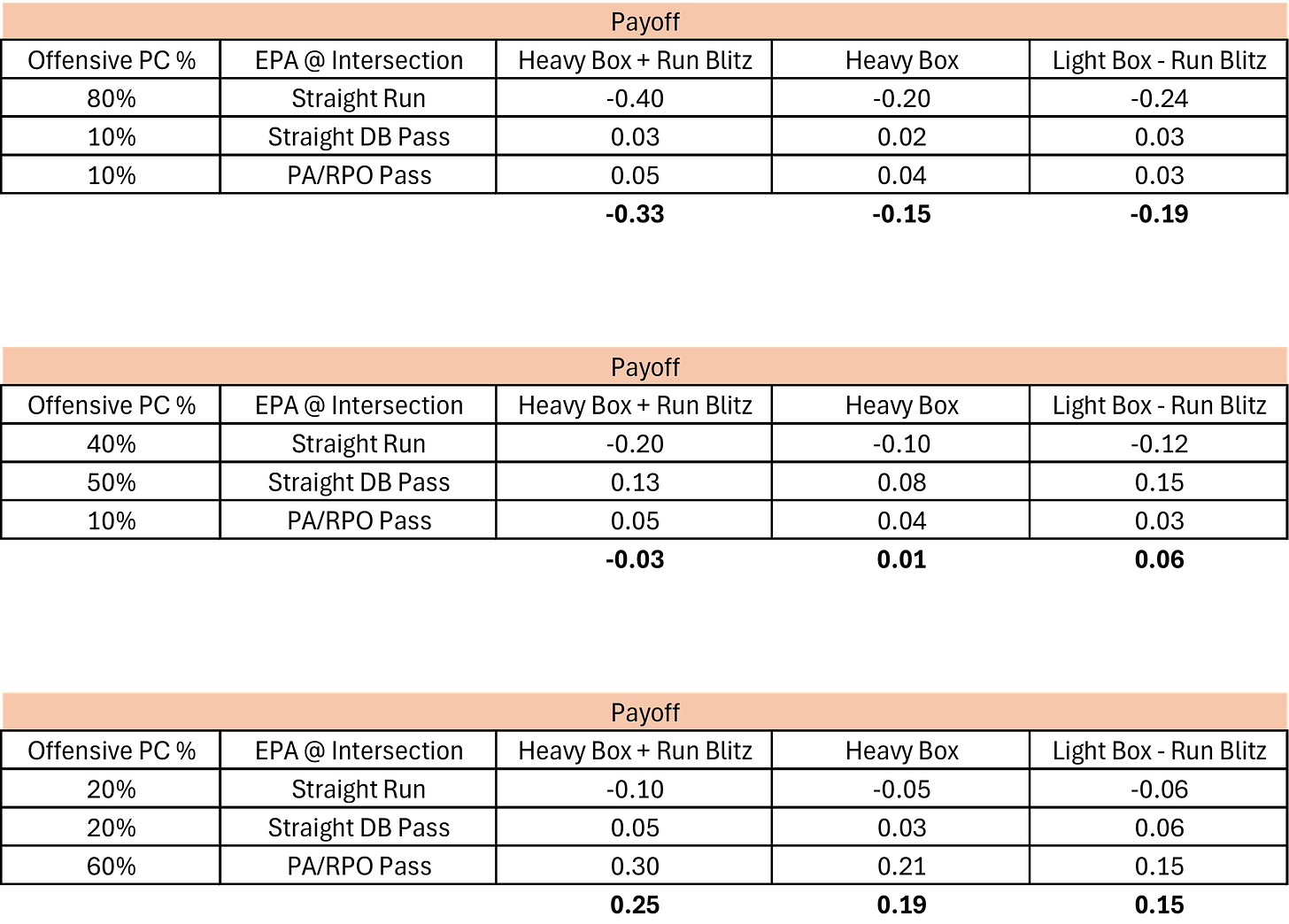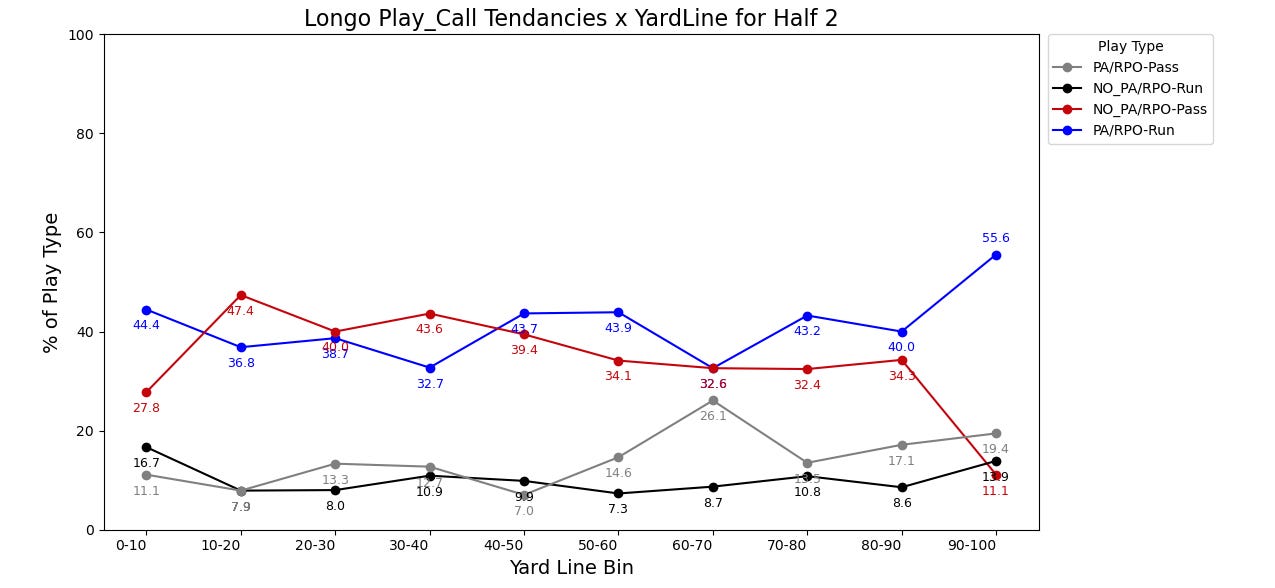Football
Wisconsin Football Analytics: Phil Longo’s Play-Call Mix
Breaking down Badgers OC Phil Longo’s play call mix.

In Part 2 of my Wisconsin Football Analytics Pre-Season Series I’m going to analyze Phil Longo’s Play-Call Mix from a Game Theory perspective.
In case you missed it, here is Part 1 & my YouTube Video on it.
Although Game Theory has made its way into the fields of Economics, Politics, Geopolitics, and War as a tool to inform strategy and optimal decision-making, it has also been used and applied to optimize Football decision-making.
But you may have never heard of it. So what is Game Theory?
Based on the definition from Investopedia:
“Game theory is the study of how and why individuals and entities (called players) make decisions about their situations. It is a theoretical framework for conceiving social scenarios among competing players.
In some respects, game theory is the science of strategy, or at least of the optimal decision-making of independent and competing actors in a strategic setting.”
If you want a deeper dive, check out this webpage: https://www.britannica.com/science/game-theory
So, as that sets the table for you. You are already seeing where the obvious application of Game Theory in Football is. Play-Calling. What is the optimal “Play-Call” in a certain situation? How can we better judge Offensive & Defensive Play-Callers? Well, we’re going to look at a specific subset of Game Theory Strategy (Mixed Strategy) and how Phil Longo’s Play-Calling is or is not optimized for that strategy.
What is Mixed Strategy in Game Theory?:
“Mixed Strategy” in game theory refers to a situation where players, instead of choosing a single pure strategy, randomize their choices among available strategies or decision points. In the context of football, it’s playcalling. What will the Offensive or Defensive Play-Caller initiate? They have at their disposal an abundance of choices in different Personnel Packages, Formations, and Play-Types.
In a “Pure Strategy” in the Offensive Play-Call context, a team would come out in 21 Personnel, Pro Formation, and Straight Handoff Run in every play. In a “Mixed” Strategy, the play-caller would have a mix of 10 – 11 – 12 – 21 personnel with a mix of different formations in those personnel packages and a mix of Straight Drobpacks, Straight Handoffs, and Play-Action/RPO Play-Types.
The idea of using a “Mixed” Strategy is to keep the opposing play-caller uncertain of what you will do. Otherwise, you could and would exploit that certainty. For example, if you saw in the data that on 80% of 1st Downs inside the RedZone, an Offensive Play-Caller calls a Straight Run. You would want to load the box & call a run-blitz or, at the very least, deploy one of those strategic decisions.
Below, we’ll examine how this might play out in a situation in a Basic Game Theory Model where you have the 80% Straight Run Mix | 40% Straight Run Mix | 20% Straight Run Mix “Payoff” matrices:

Given this data in Scenario 1, where the probability of a Stright Run is 80%, the obvious choice for a defensive coordinator to maximize the “expected” payoff would be to load the box and also put on a run-blitz. This would generate an EPA Result of -0.33 as only 20% of the time they would cede a positive EPA result.
In Scenario 2, it’s still the dominant strategy to do so, but that gap is much, much tighter. In Scenario 3, it would cease being the dominant strategy for the Defense and would actually become the worst strategy for the defensive coordinator to call.
This doesn’t reflect real-world data and is largely for effect, but it hopefully highlights the importance of unpredictability in offensive playcalling. The other component to this Model is the EPA at each intersection of an Offensive and Defensive Play-Call; where the difference in the expectation of the value generated (EPA) also drives you towards an optimal Play-Call (PC) Mix %. If everytime you did a Play-Action Pass you caught the defense off guard and scored a Touchdown, you should do that more often.
But we know the game of Football isn’t this simple…
Wisconsin Football & Game Theory | A More Advanced Game Theory Model:
The below is not actual data on Wisconsin Football and is for illustration only.

Above are what we’ll call the inputs to this “MODEL”, where we have the Offense Style & Strength & Defense Style & Stength.
This meanns we have a Probability Distribution given the Play-Type Mix (Style) and the corresponding EPA payoff (Strength) against the set of Defensive Formation and Play-Type choices. Then, we also have the data set for the Defense Style & Strength vs. the Offensive Play-Calls.
Given these inputs, we can generate a “Payoff” Model by summarising each team’s respective strengths and tendencies using the following formula.
((Probability(OFF Play-Call) × Probability(DEF Play-Call)) × OFF EPA Payoff)
PLUS (+)
((Probability(OFF Play-Call) × Probability(DEF Play-Call)) × DEF EPA Payoff)
EQUALS (=)
“Payoff”
Seen Below:

In Scenario 1 Above, at the (Play-Action/RPO <—-> Run & Heavy Box | Blitz) intersection, we can see the result using the formula above would equal:
( (25% * 17%) * -0.85) + ( (25% * 17%) * -0.25) = -0.05
In that intersection, we notice that the offense has fared really badly in those situations (-0.85 EPA), and the defense has seen a good bit of success (-0.25 EPA) in those situations. Therefore, this generates a fairly strong “payoff” for the Defense in the Model at -0.05.
Given all the inputs, you should be able to see that the Defense is far better. So given Scenario 1 where we have an equally “Mixed” Strategy where each team is equally likely to choose any of their Play-Calls, the defense would win the EPA Battle with the Offense losing an expected -0.04 using this Model.
So the obvious choice for the Offense would be to mix their Play-Calls to try and gain an advantage, right?!? Yes, but you must ensure that your Play-Call Mix moves in a more advantageous direction.
See below in Scenario 2, where the team decides to keep it simple, and limit their Play-Action and RPO game, and run base concepts the entire game. Thinking that strategy would limit mistakes and work well against this strong defense.

WRONG!
It exacerbates the disadvantage and they drop from at Total Mixed Strategy generating -0.04 in EPA to -0.07 in EPA. Not Good.
For this matchup, they need to run as much Play-Action and RPOs as possible within their scheme. You see this differential in Scenario 3, where shifting to an extremely heavy usage of Play-Action/RPO in their Run & Pass schemes generates a Total Mixed Strategy “payoff” of just slightly below 0.0. A much different and better scenario for the Offensive team.
That all changes if the Defense alters its Play-Call Mix % and switches to more optimal Play-Calls to defend against this heavy onslaught of Play-Action and RPO they are seeing. It’s a cat-and-mouse game where understanding your Opponent’s Strengths and Tendencies is critical. But just as important is knowing your own and knowing how your opponent might try to use them against you.
Phil Longo’s Play-Call Mix for Wisconsin Football
Now, let’s start examining some real data. Since you have a much better understanding of game theory, we will use it to understand optimal play-calling and check in on Phil Longo’s Style or Play-Call Mix.
Below is the data of Phil Longo’s Play Calls throughout the 2023 Season:
1st Half:

2nd Half:

Below is the summation of this data. This will be a three-part series on Play-Calling & Game Theory. So I promise you we will get back to the above charts in subsequent pieces.
For now, though, we’ll forget them and examine Play-Call Mix in Total the way we’ve been examining it so far.

As you can see, throughout the 2023 Season Longo was about 38.5% Straight Pass with no RPO or Play-Action component, and only 10.2% of all plays were straight handoffs. The labeling algorithm I used to say whether the play did or did not have an RPO/Play-Action component was complex: My Eyes & Brain. When watching the games in 2023, I tracked if there was an elongated mesh point, indicating Mordecai or Locke had the option to keep and run or pass, as well as a handoff to the RB. I would label that play PA/RPO even if they ended up handing the ball off to the RB.
I did this for an important reason.
Recap of Phil Longo’s Play-Call Tendencies for Wisconsin Football:
To bring this all together, the idea of using Game Theory as a Model in the Football context comes with an understanding that your opponent or your own tendencies are there to exploit.
When you add to the equation how that “Style” or specific tendencies match up with your strengths and then especially how they match up with your opponent’s strengths or weaknesses, you now have informed your strategic decision-making at a much higher level than before. This is the core concept of how Game Theory can be an extremely powerful tool for a Coordinator or Play-Caller when used correctly and with the right data.
Let’s go back now to Phil Longo’s Play-Call Mix.
In 2023, his Play-Call Mix dialed up a split where 78% of Wisconsin Football’s runs were with an elongated mesh point. Knowing that, you could hypothesize it probably hurt their passing game, especially when you add the context that 71% of their passes came with no Play-Action or RPO action.
Just think for a second what type of edge that knowledge could give an opposing LB or DB.
Where, if they didn’t see an immediate mesh out of the shotgun, they could drop into their zones quickly and without hesitation with 71% certainty. That’s a very big potential edge for our defensive opponents. Now. Did they take advantage of that edge? That’s something we’ll have to examine in Part Two & Part Three of this series on Phil Longo’s Play-Calling & Game Theory.
As Always…
On Wisconsin!
Thank you for taking time out of your busy day to read our work at BadgerNotes.com. For more Wisconsin Football and Big Ten content, follow us on Twitter & Facebook. You can also subscribe to our YouTube Channel. You can also follow me on Twitter @GardYourFickell or my YouTube Channel
Also, be sure to check out our shop, subscribe to our newsletter, and the BadgerNotes After Dark podcast, which is available on Apple Podcasts, Spotify, and all other streaming platforms. Because of your support, we have become one of the fastest-growing independent media outlets focused on giving a voice to the fans!












